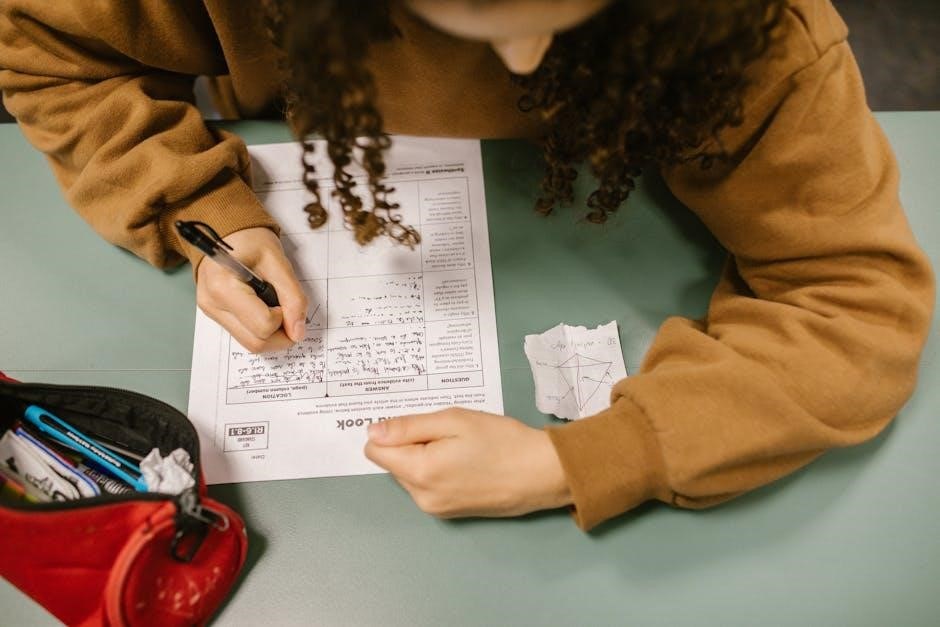Chris Voss’s “Never Split the Difference” is a groundbreaking guide on negotiation, offering practical strategies and psychological insights. As a former FBI hostage negotiator, Voss shares techniques like tactical empathy and calibrated questions to achieve successful outcomes. The book emphasizes the power of “No,” mirroring, and active listening, providing readers with tools to navigate high-stakes conversations effectively. Its importance lies in its ability to transform negotiation from confrontation to collaboration, making it indispensable for both personal and professional realms.
1.1 Overview of the Book and Its Author, Chris Voss
Chris Voss, a former FBI hostage negotiator, authored “Never Split the Difference,” a book that delves into advanced negotiation techniques. With decades of experience in high-stakes situations, Voss shares strategies like tactical empathy, mirroring, and the power of “No.” The book is complemented by a cheat sheet PDF, summarizing key concepts for quick reference. Voss’s expertise bridges the gap between law enforcement and business, making his insights invaluable for professionals and everyday negotiators alike.
1.2 Why Negotiation Skills Matter in Everyday Life
Negotiation skills are essential for resolving conflicts, securing favorable outcomes, and building strong relationships. Whether in personal or professional settings, the ability to negotiate effectively influences success. Techniques from “Never Split the Difference” empower individuals to communicate clearly, manage emotions, and understand others’ perspectives. By mastering these skills, people can navigate daily interactions with confidence, achieve mutually beneficial solutions, and enhance their overall quality of life. The cheat sheet provides a handy guide to applying these strategies effectively.

Core Concepts of Negotiation from the Book
Active listening, open-ended questions, and summarizing are key techniques. They build trust, clarify needs, and guide conversations toward mutually beneficial solutions, ensuring effective communication and understanding.
2.1 Tactical Empathy: Understanding and Connecting with Your Counterpart
Tactical empathy is a negotiation strategy where understanding and connecting with your counterpart’s emotions and perspectives are crucial. By actively listening and mirroring their words, you build rapport and de-escalate tensions. This approach, outlined in the cheat sheet, helps negotiators navigate high-stakes conversations effectively, fostering trust and collaboration. Mastering tactical empathy allows for better conflict resolution and more successful outcomes, making it a cornerstone of Voss’s negotiation techniques.
2.2 The Power of “No”: Setting Boundaries and Gaining Control
The power of “No” is a foundational concept in negotiation, enabling individuals to set clear boundaries and regain control. According to Voss, saying “No” is not just a refusal but a primal response that fosters safety and security. By embracing “No,” negotiators can establish dominance without aggression, creating space for more effective dialogue. This strategy, highlighted in the cheat sheet, empowers individuals to navigate high-stakes situations confidently, ensuring their needs are prioritized and respected in any negotiation.
2.3 Mirroring: The Art of Reflecting to Build Trust
Mirroring is a powerful technique where negotiators repeat key phrases to reflect their counterpart’s thoughts, fostering trust and rapport. This strategy, detailed in the cheat sheet, helps to create a sense of alignment, making the other party feel understood. By mirroring, individuals can diffuse tension, encourage openness, and guide the conversation toward mutually beneficial solutions, ultimately strengthening the negotiation process and building a foundation for successful outcomes.

Key Techniques for Effective Negotiation
Mastering tactical empathy, mirroring, and calibrated questions are essential for successful negotiations. These techniques help build trust, guide conversations, and uncover hidden needs, leading to better outcomes.
3.1 Open-Ended Questions: Encouraging Transparency
Open-ended questions are crucial for fostering transparency in negotiations. They encourage the counterpart to share detailed information, revealing their true needs and concerns. By asking questions like “What is it that brought us into this situation?” you invite honest dialogue, helping to uncover hidden fears and desires. This approach not only builds trust but also provides valuable insights, enabling more effective problem-solving and mutually beneficial solutions. Such questions are a cornerstone of Voss’s negotiation strategy, emphasizing understanding over confrontation. The goal is to make the other party feel heard and understood, which can significantly shift the dynamics of the conversation in your favor.
3.2 Labeling Emotions: Acknowledging and Managing Feelings
Labeling emotions involves openly acknowledging and validating the feelings of your counterpart. This technique helps to diffuse tension and build trust by showing that you understand their perspective. For example, saying, “It sounds like you’re feeling frustrated with this situation,” allows the other party to feel heard and understood. Once emotions are labeled, the conversation can shift from emotional reactions to logical problem-solving, creating a more constructive dialogue. This approach not only de-escalates conflicts but also fosters collaboration, making it easier to reach a mutually beneficial agreement.
3.3 Calibrated Questions: Guiding the Conversation
Calibrated questions are open-ended inquiries that guide the conversation without leading the counterpart to a specific answer. They often begin with “how” or “what” and encourage the other party to share their thoughts and concerns. These questions help uncover hidden information, clarify priorities, and build trust. By asking calibrated questions, negotiators can steer the dialogue toward mutually beneficial solutions while maintaining control of the discussion. This technique is essential for understanding the counterpart’s perspective and driving the negotiation forward effectively.

The Role of Psychology in Negotiation
Psychology plays a crucial role in negotiation by understanding human behavior and decision-making. Techniques like tactical empathy and labeling emotions leverage psychological principles to influence outcomes effectively.
4.1 Understanding Human Behavior and Decision-Making
Understanding human behavior and decision-making is central to effective negotiation. People are often driven by emotions rather than logic, making psychological insights crucial. Tactical empathy helps negotiators connect with counterparts, while calibrated questions uncover their priorities. By recognizing these dynamics, negotiators can influence outcomes, balancing logic with emotional drivers to achieve mutually beneficial solutions. Voss emphasizes that understanding these principles is key to mastering high-stakes conversations and securing favorable agreements.
4.2 Leveraging the “That’s Right” Moment for Agreement
Leveraging the “That’s Right” moment is a powerful technique to secure agreement. It involves summarizing your counterpart’s perspective until they acknowledge its accuracy. This moment of alignment builds trust and ensures commitment. If they respond with “That’s right,” it signals they feel understood and are ready to agree. If not, revisit open-ended questions to refine their position. This strategy ensures clarity and mutual understanding, making it easier to reach a favorable resolution.

Practical Applications of the “Never Split the Difference” Cheat Sheet
The cheat sheet offers actionable strategies for high-stakes negotiations, enabling users to apply techniques like tactical empathy and calibrated questions in real-world scenarios, ensuring effective outcomes.
5.1 How to Create Your Own Negotiation Cheat Sheet
To create a negotiation cheat sheet, list key techniques from “Never Split the Difference,” such as tactical empathy, mirroring, and calibrated questions. Include tips for applying these strategies in real conversations. Personalize the sheet by adding scenarios relevant to your life or work. Summarize core concepts like the power of “No” and labeling emotions. Organize the information clearly so it’s easy to reference during high-stakes discussions, ensuring quick access to proven negotiation tools.
5.2 Using the Cheat Sheet in High-Stakes Conversations
In high-stakes negotiations, the cheat sheet serves as a quick reference guide, ensuring you stay focused on key strategies like tactical empathy and calibrated questions. Review it beforehand to internalize techniques, maintaining confidence and clarity. Use it to guide real-time decisions, ensuring alignment with your goals. The structured format helps navigate tense moments effectively, keeping you centered on achieving optimal outcomes through proven negotiation methods.

Advanced Strategies for Difficult Negotiations
Advanced strategies involve mastering objections, leveraging “How” questions, and employing psychological tactics to unlock creative solutions, ensuring negotiations remain productive even in challenging scenarios.
6.1 Handling Objections and Difficult Counterparts
Handling objections requires empathy and strategic questioning. Use open-ended “How” questions to uncover underlying concerns and guide the conversation. Labeling emotions helps acknowledge their feelings, fostering trust. Stay calm, avoid confrontation, and employ tactical silence to regain control. Mirroring their words ensures understanding and builds rapport. By addressing objections methodically, you can transform resistance into collaboration, ensuring negotiations remain productive and aligned with your goals.
6.2 The “How” Question: Unlocking Solutions
The “How” question is a powerful tool in negotiation, encouraging creative problem-solving and collaboration. By asking open-ended questions like “How can we achieve this?” or “How can we solve this problem?” you invite the counterpart to explore solutions. This approach shifts the focus from confrontation to partnership, fostering a sense of ownership and mutual benefit. It aligns with Chris Voss’s emphasis on tactical empathy and effective communication, making it a simple yet effective way to unlock innovative solutions and reach agreements that satisfy both parties effectively.

Case Studies and Real-World Examples
Real-life examples from Chris Voss’s book illustrate how negotiation techniques successfully resolved high-stakes situations. These case studies highlight the practical application of tactical empathy and strategic communication in achieving favorable outcomes, making the concepts relatable and actionable for readers.
7.1 Successful Negotiations Using Voss’s Techniques
Chris Voss’s techniques have proven effective in real-world negotiations, as highlighted in his book. For instance, the use of tactical empathy and calibrated questions helped de-escalate high-stakes situations, such as hostage standoffs. Voss’s approach emphasizes understanding the counterpart’s perspective, which fosters trust and cooperation. By employing strategies like mirroring and labeling emotions, negotiators can guide conversations toward mutually beneficial solutions. These success stories demonstrate how Voss’s methods translate into tangible results, making them invaluable for anyone seeking to master negotiation;
7.2 Lessons Learned from Failed Negotiations
Failed negotiations often highlight the importance of understanding human behavior and emotions. Voss emphasizes that ignoring the counterpart’s emotional state can derail discussions; Additionally, overreliance on “yes” without clear commitments can lead to unresolved conflicts. Learning from these failures, negotiators should focus on building trust through tactical empathy and ensuring alignment with the counterpart’s goals. These insights underscore the need for adaptability and a deep understanding of psychological dynamics in negotiation.

The Role of Active Listening in Negotiation
Active listening is crucial in negotiation, fostering trust and understanding. By attentively hearing and summarizing the counterpart’s perspective, you gain control and build rapport, leading to better outcomes.
8.1 Why Listening Is More Important Than Speaking
Listening surpasses speaking in negotiation as it allows understanding the counterpart’s needs and emotions, building trust, and guiding conversations effectively. Voss emphasizes that silence can be powerful, revealing hidden concerns. By focusing on what’s said, you uncover underlying motivations, enabling tailored responses. This approach ensures alignment with their interests, fostering cooperation and mutual success, rather than dominance through speaking. Effective listening is the cornerstone of successful negotiation strategies.
8.2 Summarizing and Paraphrasing for Clarity
Summarizing and paraphrasing are essential tools in negotiation, ensuring understanding and alignment. By restating key points, you clarify positions, prevent miscommunication, and show active engagement. This technique also helps manage emotions, as it acknowledges the speaker’s perspective. Paraphrasing fosters trust and creates a collaborative environment, making the counterpart feel heard. It’s a subtle yet powerful way to guide the conversation toward mutually beneficial solutions while maintaining control and building rapport effectively in high-stakes discussions.

Negotiation in Business and Personal Life
Negotiation skills from “Never Split the Difference” are universally applicable, enhancing success in both business dealings and personal relationships by fostering effective communication and conflict resolution.
9.1 Applying Techniques in Workplace Negotiations
Workplace negotiations thrive with techniques from “Never Split the Difference.” Tactical empathy helps understand colleagues’ perspectives, while calibrated questions guide conversations toward mutually beneficial solutions. The power of “No” establishes boundaries, preventing overcommitment. These strategies enhance salary discussions, project management, and conflict resolution. The cheat sheet provides practical tools, ensuring effective communication and collaboration, making negotiations seamless and productive in professional settings.
9.2 Using Negotiation Skills in Personal Relationships
Negotiation skills from “Never Split the Difference” enhance personal relationships by fostering understanding and collaboration. Tactical empathy helps partners grasp each other’s emotions, while mirroring builds trust. Labeling emotions acknowledges feelings, reducing conflict. The power of “No” sets healthy boundaries, ensuring mutual respect. These techniques promote open communication, enabling couples to navigate disagreements constructively and strengthen their bond without compromising individual needs.
Master negotiation with tactical empathy, the power of “No,” and mirroring. The cheat sheet offers tools to stop compromising and start influencing effectively.
10.1 Recap of the Most Powerful Negotiation Strategies
The book highlights tactical empathy, active listening, and calibrated questions as key strategies. Using the power of “No” and mirroring builds trust and control. Summarizing and paraphrasing ensure clarity, while the “That’s right” moment confirms agreement. These techniques, outlined in the cheat sheet, empower individuals to navigate negotiations confidently, fostering collaboration and achieving desired outcomes in both professional and personal contexts effectively.
10.2 How to Continuously Improve Your Negotiation Skills
To improve negotiation skills, practice techniques like tactical empathy and mirroring in daily conversations. Reflect on past negotiations to identify strengths and areas for growth. Use the cheat sheet as a quick reference to refine strategies. Consistently apply calibrated questions and active listening to build trust. Seek feedback from others and stay adaptable, ensuring your approach evolves with experience. Regular practice and real-world application are key to mastering these proven methods.
Mastering negotiation transforms interactions, and with Voss’s insights and the cheat sheet, anyone can enhance their skills and achieve better outcomes consistently.
11.1 Final Thoughts on Mastering Negotiation
Mastering negotiation, as outlined in “Never Split the Difference,” is a transformative skill that reshapes how we approach conflicts and collaborations. By embracing tactical empathy, the power of “No,” and active listening, individuals can navigate even the most challenging conversations with confidence. The cheat sheet serves as a invaluable guide, distilling complex strategies into actionable steps. Consistent practice and a deep understanding of human psychology are key to unlocking negotiation mastery and achieving lasting success in both personal and professional realms.
11.2 Encouragement to Practice and Apply the Techniques
Embrace the strategies from “Never Split the Difference” and commit to continuous practice. Regular application of techniques like tactical empathy and calibrated questions will enhance your negotiation skills. Use the cheat sheet as a guide to refine your approach in real-world scenarios. Remember, negotiation is a skill that improves with persistence. Start applying these methods in everyday conversations and watch your relationships and outcomes transform positively. Download the cheat sheet today and take the first step toward negotiation mastery.

Additional Resources for Further Learning
Enhance your negotiation skills with the Never Split the Difference cheat sheet PDF, additional reading materials, and online courses. These resources provide in-depth insights and practical exercises.
12.1 Recommended Reading and Tools
The Never Split the Difference cheat sheet PDF is an essential tool, offering concise strategies for negotiation. Additionally, readers can explore Chris Voss’s other works and related books on negotiation psychology. Online tools like negotiation simulators and webinars complement the cheat sheet, providing hands-on practice. These resources, combined with the book’s insights, offer a comprehensive learning experience for mastering negotiation skills in both professional and personal contexts.
12.2 Online Courses and Workshops for Negotiation Skills
Online courses and workshops based on Never Split the Difference offer interactive learning experiences. Platforms provide video lessons, role-playing exercises, and real-world applications of Voss’s techniques. These programs complement the cheat sheet by teaching tactical empathy, calibrated questions, and emotional labeling. Workshops often include live Q&A sessions with experts, enabling participants to refine their negotiation strategies and apply them in high-stakes scenarios effectively.


